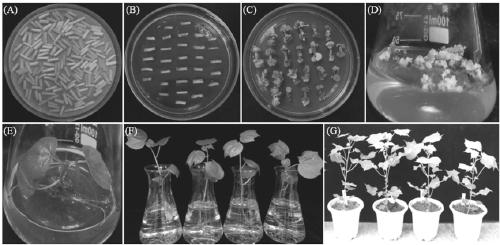Method for creating cotton apolygus lucorum-resistant germplasm by using plant-mediated RNAi
A technology of Lygus and cotton, applied in the field of plant genetic engineering, can solve the problems of affecting growth and development, abnormal molt of fruit flies, etc., and achieve the effect of improving resistance
- Summary
- Abstract
- Description
- Claims
- Application Information
AI Technical Summary
Problems solved by technology
Method used
Image
Examples
Embodiment 1
[0053] The construction of embodiment 1 Lygus chlorophylla LIM gene plant interference vector
[0054] According to the obtained nucleotide sequence of SEQ ID NO: 1, primers were designed to construct the expression vector, that is, linker bases for BP reaction were added to both ends of the designed primers, and the primer sequences were as follows:
[0055] LIM-BP-F:5'-ggggacaagtttgtacaaaaaagcaggcttgCTGGAATCGTGCCGTGTCT-3',
[0056] LIM-BP-R:5'-ggggaccactttgtacaagaaagctgggttCGCTGGCTGTCTCAGTATGG-3';
[0057] The pGEM-T-LIM plasmid was used as a template for PCR amplification, and the PCR conditions were 95°C for 5 min; 95°C for 30 sec, 58°C for 30 sec, 72°C for 30 sec, and 30 cycles; 72°C for 5 min. The correct LIM fragment containing BP adapter was obtained by PCR amplification. The PCR product was connected to the pHellsgate 4 carrier by BP reaction (BP enzyme was purchased from Invitrogen, USA; 25°C, 4 hours) and then transformed into Escherichia coli Top10 competent cell...
Embodiment 2
[0058] Example 2 Genetic Transformation and Positive Detection of Lygus LIM Gene
[0059] (1) Preparation of sterile vaccine
[0060] The test material is cotton strain J668, (patent application number: 2015108336180, invention name: a method and application for improving cotton regeneration and transformation efficiency, notice of substantive examination of the invention patent application at the public level 2017-06-14). Sowing J668 cotton aseptic seedlings under in vitro culture conditions, the specific steps are: sterilize the shelled J668 cotton seed kernels with 0.1% mercury liter on the ultra-clean workbench for 8-12 minutes, and then wash them with sterile water for 3- 4 times, inoculate the aseptic seed kernels (or explants) obtained in the aseptic seedling medium, support the seedlings one day later, remove the seed coat, and obtain the hypocotyls of the aseptic cotton seedlings after 5 days.
[0061] 2. Activation and infection of Agrobacterium
[0062] Take out t...
Embodiment 3
[0079] Example 3: Analysis of expression level of transgenic plants, establishment of expression pattern and detection of copy number
[0080] 1. Analysis of LIM gene expression:
[0081] Total RNA was extracted from leaves of transgenic T1 generation plants, and the extraction method of total RNA was referred to the improved guanidine isothiocyanate method (a conventional method).
[0082] The cDNA synthesis steps are as follows: add 3ug RNA to a new 0.5mL RNA centrifuge tube, add 1ul oligo(dT) primer (purchased from Promega), supplement DEPC water to 15μl, mix well, then denature at 70°C for 5min, place in Keep on ice for 10 minutes; add 5 μl M-MLV 5×Reaction Buffer, 1.25uL dNTP, 1uL RNasin (40U), 1uL M-MLV reverse transcriptase (purchased from Promega, USA), and rehydrate to 25uL. Gently flick the centrifuge tube to mix the solution, and incubate at 42°C for 1 hour to synthesize the first strand; after the reaction, treat at 70°C for 7 minutes to inactivate the reverse tra...
PUM
 Login to View More
Login to View More Abstract
Description
Claims
Application Information
 Login to View More
Login to View More - R&D
- Intellectual Property
- Life Sciences
- Materials
- Tech Scout
- Unparalleled Data Quality
- Higher Quality Content
- 60% Fewer Hallucinations
Browse by: Latest US Patents, China's latest patents, Technical Efficacy Thesaurus, Application Domain, Technology Topic, Popular Technical Reports.
© 2025 PatSnap. All rights reserved.Legal|Privacy policy|Modern Slavery Act Transparency Statement|Sitemap|About US| Contact US: help@patsnap.com



